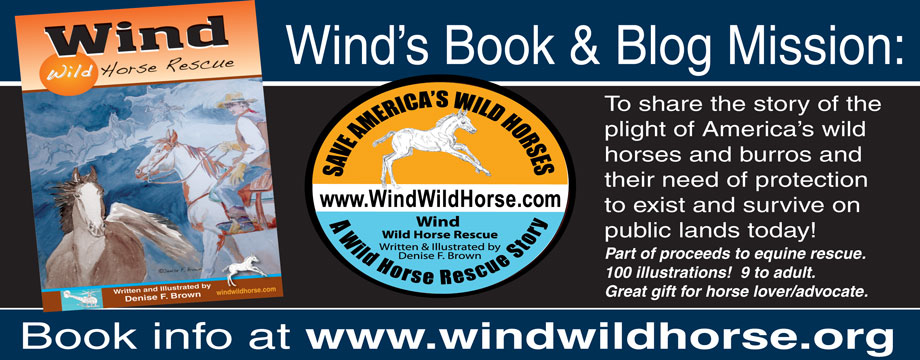Hundreds Rally to Save Arizona’s Salt River Wild Horses

|
Wild horses hovered nearby during a rally Tuesday protesting the federal government’s plans to round up and remove a well-loved herd from Tonto National Forest.
Elizabeth Stuart
|
The sun is slipping down in the sky on a 112-degree day in Tonto National Forest, casting long shadows over a small herd of horses. A dappled gray, a bay, a dun, and a knock-kneed colt with a star on her forehead snuffle through the underbrush, enjoying dinner to the sounds of chirping birds, buzzing bees, and several hundred people shouting: “Let them be! Wild and Free! Let them be! Wild and Free!”
The crowd gathered Tuesday at a recreation area near the Salt River, where between 65 and 100 such horses roam free, to protest the government’s plan to round them up and remove them from federal lands. Horses that are not claimed by Friday, the Forest Service announced last week, will be impounded, put up for sale, or “condemned or destroyed.”
“We are outraged,” Simone Netherlands, president of the Salt River Wild Horse Management Group, told demonstrators. “A roundup is not needed. It is not wanted, and we will not stand for it.”

|
Elizabeth Stuart
|
At the heart of the fight is the horses’ origin, which has been hotly contested for at least a decade.
The Forest Service claims the horses are the descendants of domesticated livestock that wandered from the nearby Salt River and Fort McDowell Indian Reservations.
But advocates argue that the wild beasts trace their lineage back to the 17th century, when Spanish missionary Eusebio Kino is believed to have brought the first horses to the area. As such, Netherlands said, they should be protected under the federal Wild and Free-Roaming Horses and Burros Act of 1971, which declares wild horses “living symbols of the historic and pioneer spirit of the West” and protects them from “capture, branding, harassment, or death.”
When the act was passed, the Bureau of Land Management conducted a survey of the nation’s free-roaming horse population and identified about 31 million acres of land as “herd management areas.” Now, the agency protects and controls about 47,329 horses residing in these fields, including about 300 in Arizona.
The Salt River wild horses, however, do not live on one of these federally recognized ranges. As a result, Forest Service officials said they are not authorized to manage the horses through monitoring and population control or outsource the work to a nongovernmental organization.
Without proper oversight, officials said, the horses could be dangerous to motorists, hikers, and campers.

|
Simone Netherlands addresses the crowd.
Elizabeth Stuart
|
Members of the Salt River Wild Horse Management Group already have been tracking the horses for more than 17 years, documenting herd dynamics, migrating patterns, and birth and death rates, Netherlands said. Each horse has a name and a file.
“These wild horses are not a safety hazard; not one incident has ever been recorded of a person being hurt by a wild horse,” she said. “They live in harmony with their natural environment. They are ecologically valuable. They reduce the risk of fire by eating dry flammable grasses.”
Hoping to prove the horses were simply overlooked, the nonprofit has started soliciting notarized memories of herd sightings prior to 1971. It unclear, however, how the documentation might affect the government’s stance. The Forest Service, in a recent grazing permit environmental assessment, already conceded that the horses have been running free along the Salt River since at least the 1930s.
“Historic evidence points to the fact that these wild horses have been here for over 400 years,” Netherlands said. “If the Forest Service just wants to return these horses to their rightful owners, they’re going to need a time machine.”

|
The crowd cheers.
Elizabeth Stuart
|
At the rally, Scottsdale attorney Bill Miller announced plans to file an injunction to block the federal government from beginning the roundup — an idea that was met with rowdy whistling and hooting.
“If we want to see what this does to the land, we have to have an study on the tourism impacts of this, the economic of impacts of this,” he said. “We’re going to get that before they start removing these horses.”
State Representative Kelly Townsend pledged to force the Forest Service to “prove” that the horses belonged to the Indian reservations.
“How do they know that?” she said. “Did they do DNA testing in 1971?”
A change.org petition to “stop the annihilation of the Salt River wild horses” had gathered nearly 63,000 signatures by Tuesday evening.
“There’s nothing quite like seeing a horse running wild and free,” said Glenda Curran, who shaded herself from the heat with an umbrella decorated with slips of paper that read, “Save our horses!” “It’s just thrilling.”
She and other protesters told New Times they frequently spot the horses while out riding, hiking, and camping.
“There’s no reason for this,” said Donna Flibbert, of the Goldfield Ghost Riders. “They are part of our history. It’s just not right that they are trying to take them away.”

|
A sign posted on the side of the road in Tonto National Forest.
|

